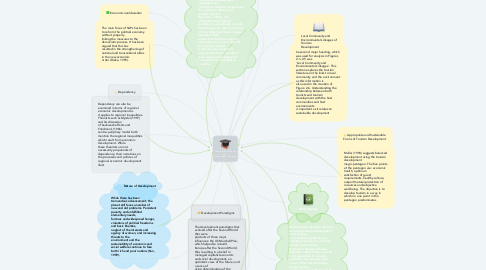The Evolution of Tourism and Development Theory cap 2
by roniber arosemena vega

1. Nature of Development
2. While there has been tremendous advancement, the planet still faces a number of new and old problems. Persistent poverty and unfulfilled elementary needs, famines and widespread hunger, violations of political freedoms and basic liberties, neglect of the interests and agency of women, and increasing threats to the environment and the sustainability of economic and social welfare continue to face both rich and poor nations (Sen, 1999).
3. Development Paradigms
4. The development paradigms that evolved after the Second World War were products of three major influences: the US Marshall Plan, which helped to rebuild Europe after the Second World War, resulting in a belief in managed capitalist economic and social development; an optimistic view of the future; and a sense of rising determination of the colonies to follow a path to independence (Dickenson et. al.,1986). These influences led to a belief in the superiority of western interventionist economics and that policy development was a linear process leading towards the same political, economic and social structures as those of the West (Dickenson et. al.,1986).
5. Dependency
6. Dependency can also be examined in terms of regional economic development as it applies to regional inequalities. Theorists such as Myrdal (1957) and his discussion of backwash effects and Friedman’s (1966) centre–periphery model both mention the regional inequalities which result from economic development. While these theorists are not necessarily proponents of dependency, their narratives on the processes and policies of regional economic development illust
7. Economic neoliberalism
8. The main focus of SAPs has been to reform the political economy without properly linking the measures to the democratic process. It has been argued that this has resulted in the strengthening of national and transnational élites in the new economic order (Dieke, 1995).
9. Alternative development
10. Since the early postwar period, mainstream development strategies have centred on economic growth and the top-down diffusion of growth impulses (Brohman, 1996a). The alternative development paradigm is a pragmatic, broadly based approach, which arose out of the criticisms of these models. Schmidt (1989) argues that there are inherent contradictions in social theories of economic change which were developed by urbanised thinkers, and which were based on development concepts from industrialised countries.
11. Modernisation
12. Modernisation has been defined as socioeconomic development, which follows an evolutionary path from a traditional society to a modern society such as North America or Western Europe (Schmidt, 1989). There is a shift from agriculture to industry and from rural to urban (see Lewis, 1954) and the money market plays a central role. The influence of the family declines and institutions become more differentiated while modern values and institutions opposed by tradition are introduced (Harrison, 1988).
13. Local Community and Environmental Linkages of Tourism Development
14. he second major heading, which was used for analysis in Figures 2.1–2.5 was ‘Local Community and Environmental Linkages’. This section explores the tourism literature on the links to local community and the environment as this information is also used in the creation of Figure 2.6. Understanding the relationship between both tourists and tourism development with the host communities and host environments is important as it relates to sustainable development
15. Appropriate and Sustainable Forms of Tourism Development
16. Muller (1994) suggests balanced development using the tourism development magic pentagon. The five points of the pentagon are: economic health, optimum satisfaction of guest requirements, healthy culture, unspoilt nature/protection of resources and subjective well-being. The objective is to develop tourism in a way in which no one point in the pentagon predominates


